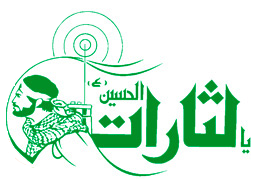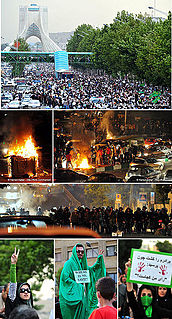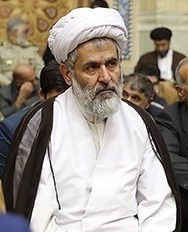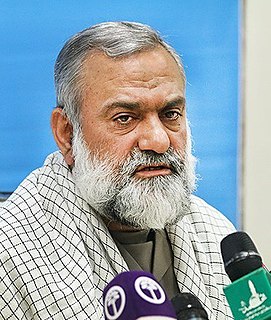Related Research Articles
The Iranian Green Movement or Green Wave of Iran, also referred to as Persian Awakening or Persian Spring by the western media,, refers to a political movement that arose after the 2009 Iranian presidential election, in which protesters demanded the removal of Mahmoud Ahmadinejad from office. Green was initially used as the symbol of Mir Hossein Mousavi's campaign, but after the election it became the symbol of unity and hope for those asking for annulment of what they regarded as a fraudulent election. Mir Hossein Mousavi and Mehdi Karroubi are recognized as political leaders of the Green Movement. Hossein-Ali Montazeri was also mentioned as spiritual leader of the movement.
The Ferdowsi University of Mashhad is a major comprehensive research university in Mashhad, capital city of the Iranian province of Razavi Khorasan. The university is named after Ferdowsi who is considered to be the national epic poet of Greater Iran, and was born in Tus, near Mashhad. It was established in 1949, making it the third oldest university in Iran.
The Iranian student protests of July 1999 were, before the 2009 Iranian election protests, the most widespread and violent public protests to occur in Iran since the early years of the Iranian Revolution.

Mir-Hossein Mousavi Khameneh is an Iranian reformist politician, artist and architect who served as the seventy-ninth and last Prime Minister of Iran from 1981 to 1989. He was a reformist candidate for the 2009 presidential election and eventually the leader of the opposition in the post-election unrest. Mousavi served as the president of the Iranian Academy of Arts until 2009, when Conservative authorities removed him.

The Basij, Niru-ye Moghāvemat-e Basij, full name Sāzmān-e Basij-e Mostaz'afin, is one of the five forces of the Islamic Revolutionary Guard Corps. A paramilitary volunteer militia established in Iran in 1979 by order of Ayatollah Khomeini, leader of the Iranian Revolution, the organization originally consisted of civilian volunteers who were urged by Khomeini to fight in the Iran–Iraq War.

Ansar-e Hezbollah is a conservative paramilitary organization in Iran. According to the Columbia World Dictionary of Islamism, it is a "semi-official quasi-clandestine organization of a paramilitary character that performs vigilante duties".

Iran's tenth presidential election was held on 12 June 2009, with incumbent Mahmoud Ahmadinejad running against three challengers. The next morning the Islamic Republic News Agency, Iran's news agency, announced that with two-thirds of the votes counted, Ahmadinejad had won the election with 62% of the votes cast, and that Mir-Hossein Mousavi had received 34% of the votes cast. There were large irregularities in the results and people were surprised by them, which resulted in protests of millions of Iranians, across every Iranian city and around the world and the emergence of the opposition Iranian Green Movement.

Major General Mohammad Ali Jafari was commander-in-chief of the Iranian Revolutionary Guard Corps from 2007 to 2019. He was appointed by Supreme Leader Ali Khamenei on September 1, 2007, succeeding Major General Yahya Rahim Safavi.

Protests against the results of the highly controversial 2009 Iranian presidential election, a disputed victory by President Mahmoud Ahmadinejad, in support of opposition candidates Mir-Hossein Mousavi and Mehdi Karroubi, occurred in major cities nationwide from 2009 into early 2010. The protests were titled the Iranian Green Movement by its proponents, reflecting Mousavi's campaign theme, and Persian Awakening, Persian Spring or Green Revolution, reflecting the "Persian identity" of Iranians and the so-called "colour revolution" theme.

The Shooting of Neda Agha-Soltan or Death of Neda Agha-Soltan drew worldwide attention after she was shot dead during the 2009 Iranian election protests. Agha-Soltan, a student of philosophy, was participating in the protests with her music teacher, and was walking back to her car when she was fatally shot in the chest.
Following the 2009 Iranian presidential election, protests against alleged electoral fraud and in support of opposition candidates Mir-Hossein Mousavi and Mehdi Karroubi occurred in Tehran and other major cities in Iran and around the world starting after the disputed presidential election on 2009 June 12 and continued even after the inauguration of Mahmoud Ahmedinejad as President of Iran on 5 August 2009. This is a timeline of the events which occurred during those protests.

Hossein Taeb is an Iranian Shia cleric and senior Islamic Revolutionary Guard Corps official who is currently the head of the IRGC's Intelligence Organization.

The 2009 Ashura protests were a series of protests which occurred on 27 December 2009 in Iran against the outcome of the June 2009 Iranian presidential election, which demonstrators claim was rigged. The demonstrations were part of the 2009 Iranian election protests and were the largest since June. In December 2009, the protests saw an escalation in violence.

Masoud Alimohammadi was an Iranian quantum field theorist and elementary-particle physicist and a distinguished professor of elementary particle physics at the University of Tehran's Department of Physics. He was assassinated on the morning of 12 January 2010 in front of his home in Tehran, while leaving for university. Majid Jamali Fashi was convicted of his killing and executed on 15 May 2012. According to Time magazine, Western intelligence confirmed that the confession of Majid Jamali Fashi was genuine.
The 2011–2012 protests in Iran were a series of demonstrations in Iran which began on 14 February 2011, called "The Day of Rage". According to BBC, the Iranian government holds the belief that the protests were infused by Iran’s revolution of 1979. The protests followed the 2009–2010 Iranian election protests and were influenced by other concurrent protests in the region.

Sane Jaleh also Sanea Jaleh, Saneh Jaleh, or Sani Zhaleh was an Iranian student at the University of Arts. He was one of two students shot dead during the February 14, 2011 demonstrations in support of Egyptians and Tunisians for ousting Presidents Hosni Mubarak and Ben Ali, in Tehran, Iran. According to news reports, "rival groups" of pro- and anti-Islamic government protesters "both claim" him and the other slain protester "as one of their supporters."

Mohammad Reza Naqdi is a senior officer in the Revolutionary Guards.

The 2011 attack on the British Embassy in Iran was a mob action on 29 November 2011 by a crowd of Iranian protesters who stormed the embassy and another British diplomatic compound in Tehran, Iran, ransacking offices and stealing documents. One small building was set on fire during the incident and several people were injured. The Iranian government publicly condemned the violence.

The 2019–2020 Iranian protests were a series of nationwide civil protests in Iran, initially caused by a 50%–200% increase in fuel prices, and leading to calls for the overthrow of the government in Iran and Supreme Leader Ali Khamenei. The protests commenced as peaceful gatherings on the evening of 15 November but spread to 21 cities within hours, as videos of the protest circulated online, eventually becoming the most violent and severe anti-government unrest since the rise of Iran's Islamic Republic in 1979.

The Ukraine International Airlines Flight 752 protests were anti-government protests that swept Iran in January 2020 after it was revealed that Ukraine International Airlines Flight 752 was shot down by the Islamic Revolutionary Guard Corps of Iran while the Iranian government covered it up.
References
- 1 2 Lyons, John (19 June 2009). "Students slaughtered in Tehran university attack". The Australian. Archived from the original on 21 June 2009. Retrieved 12 July 2009.
- 1 2 Tait, Robert (16 June 2009). "Unrest in Iran spreads to provinces as students clash with security forces". The Guardian. UK. Archived from the original on 19 June 2009. Retrieved 12 July 2009.
- ↑ Sullivan, Andrew (15 June 2009). "Tehran University's Faculty Resigns En Masse". Archived from the original on 18 June 2009. Retrieved 12 July 2009.
- ↑ "Unfortunate incidents probed at Iran university amid crackdown". CNN. 17 June 2009. Archived from the original on 20 June 2009. Retrieved 12 July 2009.
- ↑ "Iranian Ministry Seeks Probe of Deadly Raids at Tehran University". 17 June 2009. Archived from the original on 20 June 2009. Retrieved 12 July 2009.
- ↑ "MESA Letter Of Protest To Iranian Authorities" . Retrieved 10 October 2009.